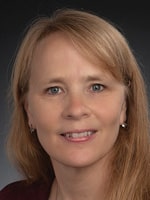Amy Carpenter
April 2024—Too few people, too much to do.
In that, Duke Health’s molecular diagnostics laboratory is no different from any other laboratory. But competing for staff on the basis of money alone is out. “The reality is that in today’s labor market, any molecular technologist can always find a job that pays more,” says Barbara Anderson, PhD, MB(ASCP)CM, analytical specialist in Duke’s molecular diagnostics laboratory, Division of Molecular Pathology, Genetics, and Genomics.
“We’re in the Research Triangle. We compete against international pharma companies, large corporate commercial laboratories, and even more small startup companies. We can’t compete effectively for an applicant or retain an employee if we rely on pay,” Dr. Anderson told CAP TODAY after speaking last fall in a workforce session at the Association for Molecular Pathology meeting, where she and her co-presenter spoke about the overall staff shortage in molecular diagnostics and cytogenetics laboratories (“Survey probes staff shortage in genomics labs,” https://bit.ly/49Z1hyZ).
“So we have to come up with ways to make the technologists feel like it’s worth it to stay in our lab even though they can make more money somewhere else. And that’s a tall order to fill,” Dr. Anderson said, describing the plight of many laboratories. How she and colleagues retain and train is what she talked about, in that “upside-down” order, she said. “Because we can’t train them if we don’t have anyone to help us train, and the valuable people are the ones we have right now.”
Underpinning most strategies is the laboratory’s clinical ladder, which in some ways functions like a “circular spider web of activities,” Dr. Anderson said. (More on that later.)
One of their main strategies for retaining people: assay “ownership” but shared responsibilities.
“Everybody knows you have lists of tasks—decontaminate the centrifuges, check the water in the eyewash stations, bleach and UV the PCR trays—every single one of those things is horrible and has to be done,” Dr. Anderson said. The schedule for them rotates so duties change. “We parse them out equally.”
“You don’t have one person stuck scraping ice out of a freezer every time it has to be defrosted. And nobody is ready to quit over decontaminating PCR trays because you do it once or twice a year.”
Dr. Anderson is often a go-between for MLS staff and directors, and the directors have good ideas—to which she often has to say no. “Because when you look at the logistics of what would be cool, it would also make them quit,” Dr. Anderson said. Case in point: “Let’s hire an entry-level person and just stick them in the extraction room and that’s their job.”
“No,” she tells them, “they’ll quit. If they have to do extractions every single day, they’re not going to stay with us more than three months.”
Everyone has their set of assays that they own and takes a turn in the extraction room. “There’s no animosity about ‘Why don’t they have to do this?’ Because extraction duty is terrible—we have so many assays, and a lot of them are manual extractions.”
Once it leaves the extraction room, Dr. Anderson said, “our approach is, ‘If this is your assay, it’s your assay. You get the DNA after it’s extracted, you set up the PCR, you run the analysis, draft the report in the LIS. It’s your assay, you own it.’”
“Having ownership helps people feel like they have a place, a purpose.”
In bringing on new assays, she and colleagues look to see if it’s an assay that has a shared software, instrument, or analytical method. “Once I can train somebody on one assay,” Dr. Anderson said, “if I have shared methodologies, then it’s methods-based training, and I can get them to do several.” Asuragen, for example, has one analysis software for three separate assays—cystic fibrosis, spinal muscular atrophy, and fragile X. The training is smoother, and “the competency assessments become easier, too,” she said. “If it’s methods-based, you don’t have to watch them do every step of every assay.”

Dr. Anderson
The molecular pathology, genetics, and genomics clinical laboratory teaching and education committee provides continuing education sessions on such things as newly validated technologies. “We recently understood we needed to sit down and explain variants,” Dr. Anderson said, because the knowledge base was lacking.
 CAP TODAY Pathology/Laboratory Medicine/Laboratory Management
CAP TODAY Pathology/Laboratory Medicine/Laboratory Management
